Blönduós,Iceland 作者: 来源: 发布时间:2021-01-20
一、人口,面积
Blönduós is a town and municipality in the north of Iceland with a population of 895 in 2018. Like many towns and villages around Iceland, Blönduós did not emerge as a village until the late 19th century. Blönduós is situated on Route 1 at the mouth of the glacial river Blanda. Hrútey, a small island and natural reserve encircled by the river, is accessible via a pedestrian bridge just off the ring road.
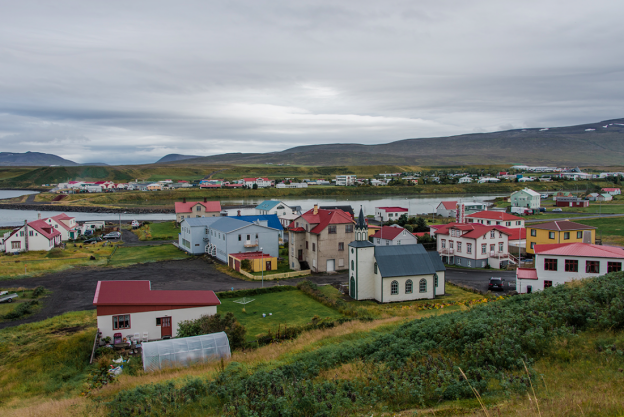
Blönduós is a municipality in Northwest Iceland, by the mouth of Blanda, as the name suggests. The settlement at Blönduós stands in a swamp under steep sea slopes, on both sides of Blöndu, and the slopes are mostly about 40 m high. The farm is built in the land of the lands Hjaltabakki and Hnjúkar, west of the river (or south of the river, as the locals say) and Ennis east (north) of the river. Highway 1 runs through Blönduós.
二、自然地理
1.地理条件
One of Blönduós' main characteristics is that the town is split into two parts by the glacial river Blanda, for which it is named (Blöndu is an oblique case of Blanda). The old part of town (Icelandic: "gamli bærinn"), including many original houses from the late 19th and early 20th century, is located on the south side of the river. Many of the local companies, the elementary school, supermarket, community center and sports facilities including a modern outdoor heated pool are located on the north side. On a hill above town is a church with striking architecture that is intended to resemble a volcanic crater.
2. 交通情况
The fire brigade is run by 2 municipalities Húnavatnshreppur and Blönduósbær. The fire brigade has 3 fire engines and a service vehicle. Ford model 1994 modified in Ólafsfjörður, Man water transport truck year 1982 modified by fire protection in collaboration with Landsvirkjun employees, Man fire truck, model year 2017, Renault kangoo 4x4 year 2006 service car Gaz 1958 which is the fire brigade's station wagon.
There are on average 15 people on the call list. Route 57 drives from Reykjavík to Akureyri and Akureyri to Reykjavík. Bus tickets are sold at Nesti - N1 in Blönduós. The goal of snow removal and de-icing is to reduce the inconvenience caused by snow and ice to individuals, businesses and schools.
三、经济发展和规模
Most of the industry and livelihood in Blönduós evolve around service for agriculture and tourism. In recent years, the town has become known for its connection with textiles. A wool washery, Iceland's only textile museum Heimilisiðnaðarsafnið and the Icelandic Textile Center, featuring a residency program for international textile artists and scholars, are all located in Blönduós. Blönduós' economy is based on a variety of food and other light industries, as well as trade and services for the district's residents and tourists.
Operations for financial items 2020 are positive by ISK 64 million. Outcome forecast
for the year 2019 assumes 63 m.kr. Operations before financial items were
49. m.kr. in 2018.
• Financial items are estimated at ISK 50 million in 2020, but were ISK 50 million. 2018.
• The operating result is positive by 14 million in 2020 but was
negative by 1 m.kr. 2018. The outcome forecast for 2019 assumes 8
million ISK surplus from the operation of Blönduósbær.
• Working capital from operations is estimated at 96 m.kr. 2020. Was 90 m.kr. 2018
The outcome forecast for 2019 assumes ISK 108 million. working capital from operations.
• 2.5% average inflation is expected in 2020, according to the forecast.
There are still disagreements in the labor market with important professions in the public sector, which can affect local budgets, e.g. with teachers and other professions. However, so-called living wage agreements made this year have laid down certain lines. The budget assumes a 5.2% increase in the wage index on an annual basis, according to the macroeconomic forecast. Wage costs in 2018 were ISK 556 million, the outcome forecast for 2019 assumes ISK 602 million, which is an increase, while for 2020 it is expected to be ISK 609 million. labor costs.
Despite extensive construction in our community in recent months, good results have been achieved in the operation of Blönduósbær, and all key figures show that it is in good balance. It is important to continue on the same path and the directors will continue to be required to exercise restraint in all operations, and the municipality's procurement issues will be examined separately in the new year. Increased supervision of the operation of policy areas and departments will now be introduced, and the position taken monthly and then quarterly, and the operation of departments will be compared with the budget.
Blönduósbær's annual accounts are prepared in accordance with the Local Government Act, the Act on Annual Accounts, the Regulation on Accounting, budgets and annual accounts of municipalities.
The municipality's operating income during the year amounted to ISK 1,232.6 million. kr. according to the consolidated financial statements for Parts A and B, of which operating income for Part A amounted to ISK 1,142.5 million. kr.
The tax rate was 14.52%, which is its statutory maximum. The tax rate on Class A real estate tax was 0.50%, but its statutory maximum is 0.625%. In Class B, the tax rate was 1.32%, which is the statutory rate. In category C, the tax rate was 1.65%, which is the statutory maximum.
The operating result of Parts A and B was positive by ISK 23.3 million. ISK, but the operating result of Part A was positive by 11.1 mill. kr. The municipality's equity at the end of the year amounted to ISK 836.2 million. kr. according to the balance sheet for parts A and B, while the equity of part A is ISK 971.7 million. kr.
The current Covid-19 pandemic will have a significant impact on many areas around the world, including the economy. There is considerable uncertainty about the economic impact of the epidemic, e.g. due to uncertainty about how long it will last and what the effect will be after it expires. It can be expected that the impact on the municipality's operations will be considerable, e.g. due to lower tax revenues and other income, deferral of due dates and increased expenses.
四、产业特点重点项目
The town council of Blönduósbær agreed at its meeting on 25 May 2010 to announce a proposal for the master plan of Blönduósbær for the period 2010-2030, acc. Paragraph 1 of Article 18 Planning and Building Act no. 73/1997 with subsequent amendments. Planning drawings, report and environmental report will be on display at Blönduósbær's office, Hnjúkabyggð 33. The proposal is also on display at the Planning Agency, Laugavegur 166, Reykjavík and on the municipality's website, www.blonduos.is, where there is also a report on archeological registration.
Blönduósbær's master plan 2010 - 2030 covers the entire land of the combined municipality of Blönduósbær and Engihlíðarhreppur and is 181 km2 in size. The plan replaces the Blönduós Master Plan 1993 - 2013. Work on the master plan for Blönduósbær began in February 2008 when a joint meeting was held with the local government and the municipality's committees. There, the planning consultants presented a proposal for a work and time plan and methodology for setting goals for the planning work. The existing zoning plans that are valid for the municipality were also reviewed.
In most respects, similar aspects of the master plan are being addressed as Local Agenda 21, which is the municipality's strategy that aims to make the community even better for the residents and the environment. Local Agenda 21 is a comprehensive plan for the development of each community into the 21st century. The plan is not only about the environment in the ordinary sense, but it is also intended to take into account economic and social factors, and is therefore primarily a welfare plan.
Municipalities are obliged to prepare a master plan for the whole country within the municipality's boundaries. According to the Planning Act, sustainable development must be the guiding principle in the formulation of the master plan, which is the same basic principle as that behind Local Agenda 21.
In the area according to the current master plan mixed land use for community services, residential areas, trade, services, economic activities and open areas for special use in accordance with the terms of the current master plan. The area is expected to have business activities mixed with trade and services. The area is mostly uninhabited and therefore there is scope for new construction, which is part of the utilization of the area. The development of the area aims to strengthen and beautify the streetscape and the attractive appearance of the area will be promoted and emphasis will be placed on quality environmental finishing.
五、风景名胜,景点
1. The Home Industry Museum
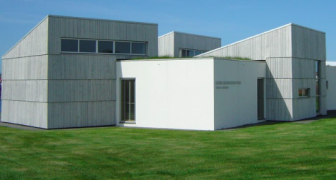
The museum is in a magnificent building where visitors' access is excellent. The museum's objects form several different and independent exhibitions: an embroidery exhibition, an exhibition of Icelandic national costumes, Halldórustofa which is dedicated to the life and work of Halldóra Bjarnadóttir (1873-1981), a wool exhibition and an annual special exhibition of textile artists.
2. Hrútey
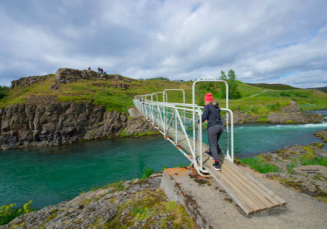
Hrútey became an open forest in 2003. Hrútey is on the main road by highway no. There are good parking spaces by the river bank and a solid footbridge to the island. Hrútey is ideal as an outdoor and recreational place. There are good footpaths and clearings with benches and tables. It is a short walk to the sea from Hrútey along a footpath along the river. Guests are advised to take special care along the riverbanks. Camping sites are close to Hrútey and close to a variety of services in Blönduósbær.
Hrútey was protected as a public park in 1975. The area is open to the public, but rules on traffic and use must be followed. Hrútey is protected from all traffic from April 20 to June 20 due to the nesting of birds, especially geese.
3. BIRDING TRAILS
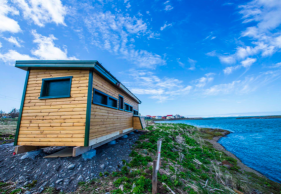
The rich bird life of Northern Iceland, distributed over widely varying habitats, displays a diversity seldom surpassed in Iceland and accessible areas for seeing species such as the Barrow’s Goldeneye, Harlequin Duck, Gyr Falcon, Rock Ptarmigan, the Great Northern Gannet and the Guillemot. Wetlands are important as a habitat for many Icelandic breeding species, and of the Icelandic wetlands which are famed for rich bird life, several of the most renowned are in North Iceland. Click for more information.
This website is not hosted by the Birding Iceland Community. This website only contains information about the 3 birding trails of North Iceland and information about traveling around the area. For information about the Icelandic Birding Community please visit www.facebook.com/birdingiceland.
六、历史文化
1.历史
The town was originally in two municipalities, the settlement south of the river belonged to Torfalækjarhreppur and north of Engihlíðarhreppur, but in 1914 Torfalækjarhreppur was divided and the settlement south of the river became a special district, Blönduóshreppur. On February 1, 1936, the settlement north of the river was merged with the rest of the town. He was granted town rights on 4 July 1988 and was then called Blönduósbær, and that name continued with the merger with Engihlíðarhreppur on 9 June 2002.
Blönduós is first mentioned as a landing place in Landnámabók and in many Icelandic sagas there is talk of ship arrivals there, but in later centuries it does not seem to have been sailed there until the 19th century. The only shopping place in Húnaþing was then Höfðakaupstaður (Skagaströnd). Many Húnvetningar, however, thought it was a long way to get a store there and on January 1, 1876, Blönduós was legalized as a store. The following summer, several retail plots were measured and two retail sheds were built. Kaupfélag Austur-Húnvetningar got a measured plot in 1896 and in 1909 a concrete shopping center was built which still stands.
Residential buildings were also erected around the shops. In 1890 there were 52 inhabitants in Blönduós and by the turn of the century they had become 106. In 1920, Blönduós had 11 stone houses, 15 wooden houses and 31 turf farms. A ferry arrived at the mouth of Blanda around the time construction began there and a bridge was built in the years 1896-1897 and was a great improvement in transport and also connected the village, which was being built on both sides of the river. The current bridge was built in 1962-1963. In the years 1894-1895, a pier was built outside the river and Blönduós then became a permanent stop for coastal cruise ships.
The Húnvetningar girls' school was moved to Blönduós in 1901 and the current school building was built in 1912. The school operated until 1978 but was then closed down and the Textile Center of Iceland and the Home Industry Museum are now in the school's premises. Blönduós also has the Hafís Center in Hillebrandtshús and the Icelandic Salmon Center is being set up in the town.
The old church at Blönduós was moved there from Hjaltabakki in 1894 and built south of the river. It is now protected, but a new church was built in the north in 1993. The rectory has been in Blönduós since 1968. The district commissioner of Húnvetningar has been based in Blönduós since 1897 and the same year it became a medical center. The hospital, Héraðshæli Austur-Húnvetningar, was opened in 1956. Blönduós has been the Meteorological Office's automatic meteorological observatory since 1998.
2. 文化体育
Childhood is a special stage of development that must be taken into account and respected. Barnabær preschool has been operated at Hólabraut 17 since 1981. Barnabær operates according to the National Curriculum Guide for preschools. The preschool is a four-department preschool and the children are aged 8 months - 6 years in age-divided departments. Flexible placement time is offered and the kindergarten is open from 7.45 - 16.15.
Blanda School is located by Húnabraut. The school's students are in ten classes in grades 1-10. The school has a sports center and swimming pool. The staff and teachers are 25. The school operates its own website and more information about it can be found here. The school day care center is operated at Blönduskóli, where accommodation is offered for children in grades 1-4. bench. Opening hours are from 13:00 to 16:00. Non-refreshments are available for the children. On planning days (unless otherwise stated) and parent interview days, the placement is open from 08: 00-16: 00 and the children then receive 3 meals during the day.
We put a lot of effort into outdoor activities, but we also have good indoor facilities where the children can take part in various games, but we have a good selection of craft toys, games, puzzles, lego, playmo, barbie and most everything that children have fun. Students can study distance learning at FNV from Blönduós. The goal is for students to be able to complete general vocational subjects and core subjects of student studies in their home area. Students in distance learning take part in all major events and travels organized by the school. Students in distance learning are part of the student groups in FNV. All teaching takes place through teleconferencing equipment from Sauðárkrókur and teachers are located there. Teachers post content on the Moodle social networking site and students submit assignments and some exams throughout. Students in distance learning take all exams at Blönduós.
At the beginning of the second semester, students from distributed studies attend the school in Sauðárkrókur and meet teachers and administrators. There are a total of 3-4 standard sessions each semester, one week at a time. The standard sessions are important, but the goal is to connect students and teachers. In addition, students have the opportunity to participate in social life in a larger school environment. Events at the student association are determined by the dates of the standard sessions, so that students in distributed learning can take part in the biggest events of the winter. Travel arrangements have been made in such a way that students bring a bus on Sunday evening and are at the FNV dormitory for food and accommodation and then also return by bus on Friday or Saturday, as the case may be. These days, students take part in traditional lessons, but can also use the services of teachers in project work and also teachers use this time if it is a practical aspect or another type of work that is better to have students on site.
The study room at Blönduós is located in the Women's School at Árbraut 31. The study room has teleconferencing equipment. Distance students have access to computers. Farskólinn's contact person for the classroom is Katharina Schneider, director of the Knowledge Center in Blönduós, but the Knowledge Center is in the same building. The phone numbers are: 452-4030 and 899-9271.
Tónlistarskóli Austur - Húnavatnssýsla was founded in 1971. There were three teaching places immediately, Blönduós, Húnavellir and Skagaströnd. Initially, the school was run by the municipalities to 1/3, the Music Association to 1/3 and tuition fees to 1/3, but now the school is run by Byggðasamlag for music schools.
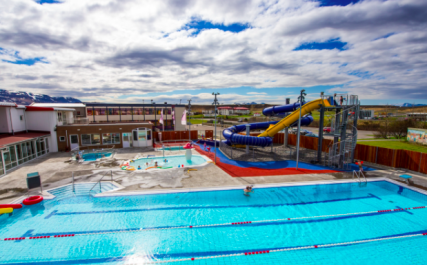
All information can be found on the website of the sports center in Blönduós, Address: Húnabraut 6, Skjólinn's employees: Páll Rúnar Heinesen Pálsson - director, Gísli Ragnarsson - leisure supervisor, Anton Haraldsson - leisure supervisor and Gurðún Tinna Rúnarsdóttir - leisure supervisor. Félagsmiðstöðin Skjólið is located on the second floor of Félagsheimilis in Blönduós and is operated for 36 weeks during the winter. The activity is intended for 10-15 year olds in Blönduósbær. For teenagers aged 13-15, it is open every Tuesday and Wednesday evening from 20-22. It is open every other Thursday night from 20-22 and every other Friday night from 20-23. For kids aged 10-12, it is open every Friday from 13-15.
Great pool for everyone, the pool is 25x8.5 meters in size, two hot tubs, steam, wading pool, ice bath and two large slides and lots of fun toys and toys. There are various things available for the kids to do in the Shelter, such as: Pool, table tennis, hot hockey, internet desktop computer, free Wi-Fi access, room with 65 ”smart TV and PS3 and PS4 consoles (no games allowed), ballroom with projector and tent with regular movies and live broadcasts, Ipad, AppleTV with access to Netflix (no forbidden movies allowed) and a new sound system with DJ gadgets.
In the autumn, the Youth Council of Skjólinn is elected, which is composed of seven teenagers from 8.-10. grade of Mixed School. The council meets weekly and organizes e.g. program and prepares openings for the community center. All facilities for sports and outdoor activities are worthy. There are many fun hiking trails in the vicinity of Blönduós. Here is a recent sports center with legal basketball and handball courts. There is an endurance room and a lifting equipment room that is useful for groups and individuals. There is a 25 meter long swimming pool as well as a pool garden with hot tubs, a wading pool and water slides. An elegant grass field for football and free sports is in the center of town. Just above the town, in Vatnahverfi, is a decent 9-hole golf course. There are very good facilities for horse riding, angling, shooting, off-road and more.
七、其他信息
Blönduós' surroundings are overgrown with grass and emphasis is placed on a clean and tidy environment. Blönduósbær operates its own waste sorting and reception of hazardous waste. Blönduós also has a landfill for Blönduós and neighboring forces, and it has an operating license from the Health Protection Agency. Blönduós has built a sewer and sewage is provided through a treatment plant that roughly cleans all waste from residents and companies.
八、联系方式
Town manager: Kimmo Jarva
Phone: 455 4700
Email: blonduos@blonduos.is
Address: Hnjúkabyggð 33/540 Blönduós
